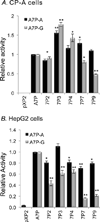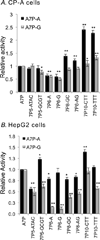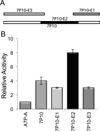Single-nucleotide polymorphisms interact to affect ADH7 transcription
- PMID: 24512552
- PMCID: PMC3984380
- DOI: 10.1111/acer.12340
Single-nucleotide polymorphisms interact to affect ADH7 transcription
Abstract
Background: The class IV alcohol dehydrogenase (ADH7, μ-ADH, σ-ADH) is important in the metabolism of ethanol and retinol. ADH7 is the only ADH not expressed in liver, instead being expressed mainly in the upper gastrointestinal tract. Genome-wide studies have identified significant associations between single-nucleotide polymorphisms in ADH7 and alcoholism and cancer, but the causative variants have not been identified.
Methods: In vitro studies of gene expression by transient transfection into cell lines that express endogenous ADH7 (CP-A cells) and that do not (HepG2 cells).
Results: We have identified transcriptional regulatory elements of ADH7 and observed differences in the effects of variants on gene expression in CP-A cells and HepG2 cells. Two haplotypes of the proximal promoter that differ in a single nucleotide at rs2851028, A7P-G and A7P-A, have different transcriptional activities. There is an interaction between variants farther upstream and these proximal variants: Upstream regulatory sequences generally showed a greater increase or smaller reduction in activity when combined with the A7P-A promoter than with the A7P-G promoter. A sequence located 12.5-kb upstream (7P10) can function as an enhancer. In CP-A cells, both haplotypes of 7P10 increased A7P-A activity by 2.5-fold while having only 1.2-fold effect on A7P-G. In HepG2 cells, the 7P10-TTT haplotype had no effect on the A7P-A promoter but decreased A7P-G promoter activity by 50%, whereas the CTT haplotype increased A7P-A activity by 50%, but had no effect on A7P-G.
Conclusions: These complex interactions indicate that the effects of variants in the ADH7 regulatory elements depend on both sequence and cellular context and should be considered in interpretation of the association of variants with alcoholism and cancer.
Keywords: Alcohol Dehydrogenase 7; Alcoholism; Class IV Alcohol Dehydrogenase; Gene Regulation; Genetic Association.
Copyright © 2014 by the Research Society on Alcoholism.
Figures






Similar articles
-
An enhancer-blocking element regulates the cell-specific expression of alcohol dehydrogenase 7.Gene. 2014 Sep 1;547(2):239-44. doi: 10.1016/j.gene.2014.06.047. Epub 2014 Jun 24. Gene. 2014. PMID: 24971505 Free PMC article.
-
Possible epistatic role of ADH7 in the protection against alcoholism.Am J Med Genet B Neuropsychiatr Genet. 2004 Apr 1;126B(1):19-22. doi: 10.1002/ajmg.b.20136. Am J Med Genet B Neuropsychiatr Genet. 2004. PMID: 15048643 Review.
-
Genomic structure and expression of the ADH7 gene encoding human class IV alcohol dehydrogenase, the form most efficient for retinol metabolism in vitro.J Biol Chem. 1995 Mar 3;270(9):4305-11. doi: 10.1074/jbc.270.9.4305. J Biol Chem. 1995. PMID: 7876191
-
Considerable haplotype diversity within the 23kb encompassing the ADH7 gene.Alcohol Clin Exp Res. 2005 Dec;29(12):2091-100. doi: 10.1097/01.alc.0000191769.92667.04. Alcohol Clin Exp Res. 2005. PMID: 16385178
-
Variation in gastric alcohol dehydrogenase and the risk of alcohol dependence.Arch Med Sadowej Kryminol. 2016;66(3):172-181. doi: 10.5114/amsik.2016.66401. Arch Med Sadowej Kryminol. 2016. PMID: 28453170 Review. English.
Cited by
-
Pharmacogenomic Study Reveals New Variants of Drug Metabolizing Enzyme and Transporter Genes Associated with Steady-State Plasma Concentrations of Risperidone and 9-Hydroxyrisperidone in Thai Autism Spectrum Disorder Patients.Front Pharmacol. 2016 Dec 2;7:475. doi: 10.3389/fphar.2016.00475. eCollection 2016. Front Pharmacol. 2016. PMID: 28018217 Free PMC article.
-
Prognostic implications of alcohol dehydrogenases in hepatocellular carcinoma.BMC Cancer. 2020 Dec 7;20(1):1204. doi: 10.1186/s12885-020-07689-1. BMC Cancer. 2020. PMID: 33287761 Free PMC article.
-
System Biology Investigation Revealed Lipopolysaccharide and Alcohol-Induced Hepatocellular Carcinoma Resembled Hepatitis B Virus Immunobiology and Pathogenesis.Int J Mol Sci. 2023 Jul 6;24(13):11146. doi: 10.3390/ijms241311146. Int J Mol Sci. 2023. PMID: 37446321 Free PMC article.
-
Prognosis genes in gastric adenocarcinoma identified by cross talk genes in disease‑related pathways.Mol Med Rep. 2017 Aug;16(2):1232-1240. doi: 10.3892/mmr.2017.6699. Epub 2017 Jun 6. Mol Med Rep. 2017. PMID: 28586067 Free PMC article.
-
An enhancer-blocking element regulates the cell-specific expression of alcohol dehydrogenase 7.Gene. 2014 Sep 1;547(2):239-44. doi: 10.1016/j.gene.2014.06.047. Epub 2014 Jun 24. Gene. 2014. PMID: 24971505 Free PMC article.
References
-
- Bierut LJ, Goate AM, Breslau N, Johnson EO, Bertelsen S, Fox L, Agrawal A, Bucholz KK, Grucza R, Hesselbrock V, Kramer J, Kuperman S, Nurnberger J, Porjesz B, Saccone NL, Schuckit M, Tischfield J, Wang JC, Foroud T, Rice JP, Edenberg HJ. ADH1B is associated with alcohol dependence and alcohol consumption in populations of European and African ancestry. Mol Psychiatry. 2012;17:445–450. - PMC - PubMed
-
- Birley AJ, James MR, Dickson PA, Montgomery GW, Heath AC, Whitfield JB, Martin NG. Association of the gastric alcohol dehydrogenase gene ADH7 with variation in alcohol metabolism. Human Molecular Genetics. 2008-a;17:179–189. - PubMed
-
- Bongaerts BWC, De Goeij AFPM, Wouters KAD, Van Engeland M, Gottschalk RWH, Van Schooten FJ, Goldbohm RA, Van Den Brandt PA, Weijenberg MP. Alcohol consumption, alcohol dehydrogenase 1C (ADH1C) genotype, and risk of colorectal cancer in the Netherlands Cohort Study on diet and cancer. Alcohol (Fayetteville, N.Y.) 2011;45:217–225. - PubMed
-
- Botelho NK, Schneiders FI, Lord SJ, Freeman AK, Tyagi S, Nancarrow DJ, Hayward NK, Whiteman DC, Lord RVN. Gene expression alterations in formalin-fixed, paraffin-embedded Barrett esophagus and esophageal adenocarcinoma tissues. Cancer Biology & Therapy. 2010;10:172–179. - PubMed
Publication types
MeSH terms
Substances
Associated data
- Actions
- Actions
Grants and funding
LinkOut - more resources
Full Text Sources
Other Literature Sources
Research Materials
Miscellaneous

